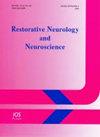预防化疗引起的认知障碍的测量、机制和潜在治疗
IF 1.6
4区 医学
Q4 NEUROSCIENCES
引用次数: 0
摘要
化疗后的认知障碍,也被称为化学脑,正在降低数百万癌症患者的生活质量。寻找治疗化学脑的方法迫在眉睫。事实上,测量和机制都还没有被定义。为了找到有效的治疗化学脑的方法,本文首先介绍了功能磁共振成像(fMRI)和正电子发射断层扫描(PET)等客观准确的方法在化学脑测量中的应用。此外,我们还强调了化学脑的潜在机制包括神经炎症、细胞凋亡和突触变性。化疗可引起脑内神经炎症和细胞凋亡。化疗小鼠的突触可塑性也有所下降。在其他认知功能障碍病变的基础上,我们也致力于寻找癌症患者化疗后认知功能障碍的有效治疗方法。突触修复、干细胞移植、中药和心理康复都是治疗化学脑的有力选择。本文章由计算机程序翻译,如有差异,请以英文原文为准。
Measurements, mechanisms and potential therapy for preventing chemotherapy-induced cognitive impairment
Cognitive impairment following chemotherapy, also called chemobrain, is reducing the life quality of millions of cancer patients. It is urgent to discover therapeutic methods against chemobrain. In fact, neither measurements nor mechanisms are yet to be defined. To discover efficient treatment on chemobrain, in this review, we firstly focus on applications of objective and accurate methods to study the measurement of chemobrain, such as Functional magnetic resonance imaging (fMRI) and positron emission tomography (PET). Furthermore, we highlight the potential mechanism of chemobrain including neuroinflammation, cell apoptosis and synaptic degeneration. Chemotherapy can induce neuroinflammation and cell apoptosis in brain. Synaptic plasticity also decreased in chemo-agent treated mice. Based on other cognitive impairment diseased, we also engaged in looking for effective treatment on cognitive impairment after chemotherapy in cancer patients. Synaptic repair, stem cell transplantation, Chinese medicine and psychological rehabilitation are all powerful candidates for treating chemobrain.
求助全文
通过发布文献求助,成功后即可免费获取论文全文。
去求助
来源期刊
CiteScore
5.40
自引率
3.60%
发文量
22
审稿时长
>12 weeks
期刊介绍:
This interdisciplinary journal publishes papers relating to the plasticity and response of the nervous system to accidental or experimental injuries and their interventions, transplantation, neurodegenerative disorders and experimental strategies to improve regeneration or functional recovery and rehabilitation. Experimental and clinical research papers adopting fresh conceptual approaches are encouraged. The overriding criteria for publication are novelty, significant experimental or clinical relevance and interest to a multidisciplinary audience. Experiments on un-anesthetized animals should conform with the standards for the use of laboratory animals as established by the Institute of Laboratory Animal Resources, US National Academy of Sciences. Experiments in which paralytic agents are used must be justified. Patient identity should be concealed. All manuscripts are sent out for blind peer review to editorial board members or outside reviewers. Restorative Neurology and Neuroscience is a member of Neuroscience Peer Review Consortium.

 求助内容:
求助内容: 应助结果提醒方式:
应助结果提醒方式:


